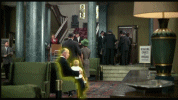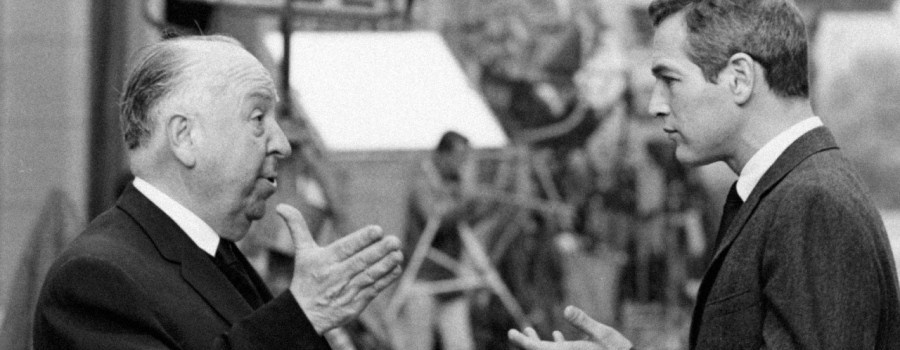Torn Curtain (1966)
| It tears you apart with suspense! | |
/0004.jpg) | |
| Alfred Hitchcock | |
| Alfred Hitchcock | |
| Brian Moore Willis Hall Keith Waterhouse | |
| Paul Newman Julie Andrews Lila Kedrova Hansjörg Felmy | |
| John Addison | |
| John F. Warren | |
| Bud Hoffman | |
| 128 minutes (theatrical version) | |
| colour (Technicolor) | |
| mono (Westrex Recording System) | |
| 1.85:1 | |
| Universal Pictures | |
| DVD & Blu-ray | |
Synopsis
U.S. rocket scientist Michael Armstrong and his assistant/fiancée Sarah Sherman are attending a convention in Copenhagen. Michael is acting very suspiciously and Sarah follows him to East Germany when he apparently tries to defect to the other side.
Production
Following the completion of Marnie, Hitchcock began planning to fulfil his long-held desire to film an adaptation of J.M. Barrie's melancholic play "Mary Rose", which he saw when it premièred in London in April 1920. Marnie screenwriter Jay Presson Allen was hired to develop a draft screenplay and Albert Whitlock created a number of design sketches. Despite their strained relationship during the filming of Marnie, Hitchcock had intended Tippi Hedren to take the lead role of Mary Rose, and veteran actress Fay Compton — who was the original stage Mary Rose — was approached to play a minor role in the film. However, executives at Universal refused to green light the project and Hitchcock reluctantly put it to one side.[1][2]
According to biographer Patrick McGilligan, Hitchcock then began developing three separate project simultaneously — a crime caper in the style of Mario Monicelli's Big Deal on Madonna Street (1958) featuring a family of Italian crooks that was tentatively titled R.R.R.R., a crime drama inspired by the English murders Neville Heath and John Christie (elements of which would later resurface in the Kaleidoscope project) that would act as a kind of prequel to Shadow of a Doubt, and a gritty political spy thriller. It was this latter project, which Hitchcock dubbed a "realistic Bond", that Universal repeatedly encouraged the director to pursue and would eventually lead to Torn Curtain becoming his next film.[3]
In August 1964, Hitchcock renegotiated his contract with Universal — in return for the studio acquiring ownership of Shamley Productions and the distribution rights to Alfred Hitchcock Presents, The Alfred Hitchcock Hour and the five Paramount films that had reverted to the director[4], Hitchcock became the third largest shareholder in the studio. Although the new contract gave Hitchcock financial security and wealth, it essentially curtailed the enormous artistic freedoms he had enjoyed during his years at Paramount in the 1950s.[5]
Pre-Production
Screenplay
Hitchcock's initial plans for his "realistic Bond" film centred around a scientist who defects to Russia and the impact this has on his wife. In November 1964, he wrote to Vladimir Nabokov in the hope the Russian émigré novelist could be persuaded to write an original screenplay. Hitchcock told Nabokov, "The question I'm really interested in is what would be the attitude of a young woman, perhaps in love with, or engaged to a scientist who could be a defector."[6] Despite expressing interest in working with the director, Nabokov's busy schedule meant it would be the summer of 1965 before he could consider starting work.[7]
Next, Hitchcock approached Irish-born Canadian novelist and screenwriter Brian Moore, whose 1955 novel Judith Hearne the director greatly admired. Despite Moore's initial reluctance, he met with Hitchcock and eventually agreed to work on the screenplay when Universal doubled their pay offer to $50,000.[8]
By the end of March 1965, Moore had completed a five page synopsis that broadly mirrors the final film. A longer treatment was finished by the middle of May, and a complete first draft was submitted by on June 21st. He continued work over the summer and completed a third draft by the start of August. By now, Moore was exhausted and becoming disillusioned with the project — when Hitchcock requested further work on the script a few weeks later, the writer bluntly told him, "...if [this] were a book I were writing, I'd scrap it, or do a complete rewrite".[9][10]
Although Moore later realised his comments had offended Hitchcock and he wrote to say he would be happy to continue working on the script, the director had already hired the English writing team of Keith Waterhouse and Willis Hall, who arrived into Hollywood shortly before production commenced in November. Waterhouse later recalled, "We often found ourselves revising scenes only hours before they were to be shot [...] a messenger would be waiting to rush our latest rewrites across to the Torn Curtain sound stage, where they would be thrust into the hands of the actors even as Hitchcock lit them for the scene."[11][12]
Casting
Universal executives were keen for Torn Curtain to be a return to Hitchcock's Paramount-era films, with big name stars and colourful locations. In the spring of 1965, Hitchcock met with Cary Grant but the actor was already committed to filming Walk, Don't Run in Tokyo and was planning to retire afterwards. Lew Wasserman lobbied hard for younger lead actors and the studio persuaded the director to select two of Hollywood's biggest stars, Paul Newman and Julie Andrews.[13][14]
Hitchcock apparently was unable to warm to either of the actors and privately griped to François Truffaut that their combined salary "of $1,500,000 is more than we have to pay for the cost of the rest of the picture." The director also struggled to decide whether to make the character of the defecting scientist or his wife the emotional core of the film and, in Brian Moore's words, Hitchcock felt "inhibited" by the casting.[15]
Principal Photography
Due to the difficulties of filming in East Germany, a German second unit was hired to surreptitiously capture various locales and scenery that could then be edited into the film to add an air of authenticity. However, their footage proved to be substandard in quality and couldn't be used. Instead, Hitchcock resorted to using American locations to double as European ones: Berlin's Schönefeld Airport was replicated at a San Fernando Valley airport, exteriors of the East Berlin farm were filmed near Camarillo, Long Beach harbour stood in for the Swedish docks, and Karl Marx University was actually the University of Southern California.[16]
Post-Production
Release & Reception
To tie in with the release of the film, an adaptation novel written by Richard Wormser — based on Moore's screenplay — was published by Dell.
See Also...
For further relevant information about this film, see also...
- 1000 Frames of Torn Curtain (1966)
- articles about Torn Curtain (1966)
- complete cast and crew
- documentaries
- soundtrack albums
- trailers
- trivia
- web links to articles, information, reviews, etc
Blu-ray Releases
released in 2012

|
Torn Curtain (1966) - Universal (Blu-ray, 2012) as part of the box set: Alfred Hitchcock: The Masterpiece Collection - Universal (Blu-ray, 2012) |
DVD Releases
released in 2006

|
Torn Curtain (1966) - Universal (USA, 2006) NTSC 1.85:1 (anamorphic) |
released in 2005

|
Torn Curtain (1966) - Universal (UK, 2005) PAL |

|
Torn Curtain (1966) - Universal (USA, 2005) - part of a box set NTSC 1.85:1 (anamorphic) [02:07:36] |
Image Gallery
Images from the Hitchcock Gallery (click to view larger versions or search for all relevant images)...
posters
lobby cards
other images
Film Frames

Themes
- the MacGuffin - the secret formula known by Prof Lindt
- the icy blonde - Sarah Sherman (Julie Andrews)
- the knife not quite killing Gromek
- the Hitchcock cameo - sat in the hotel lobby nursing a small child (more details)

Cast and Crew
Directed by:
Starring:
- Paul Newman - Professor Michael Armstrong
- Julie Andrews - Sarah Sherman
- Lila Kedrova - Countess Kuchinska
- Hansjörg Felmy - Heinrich Gerhard
- Tamara Toumanova - Ballerina
- Wolfgang Kieling - Hermann Gromek
- Ludwig Donath - Professor Gustav Lindt
- Günter Strack - Professor Karl Manfred
- David Opatoshu - Mr Jakobi
- Gisela Fischer - Doctor Koska
- Mort Mills - Farmer
- Carolyn Conwell - Farmer's Wife
- Arthur Gould-Porter - Freddy
- Gloria Gorvin - Fräulein
Produced by:
Written by:
Photographed by:
Edited by:
Music by:
Costume Design by:
Production Design by:
Notes & References
- ↑ Alfred Hitchcock: A Life in Darkness and Light (2003) by Patrick McGilligan, pages 650-653
- ↑ Hitchcock and the Making of Marnie (2013) by Tony Lee Moral, chapter 10: Mary Rose
- ↑ Alfred Hitchcock: A Life in Darkness and Light (2003) by Patrick McGilligan, chapter 17
- ↑ Namely, Rope (1948), Rear Window (1954), The Trouble with Harry (1955), The Man Who Knew Too Much (1956) and Vertigo (1958). In 1983, following Hitchcock's death, Universal acquired the full rights to the films for a reported figure of $6,000,000.
- ↑ Alfred Hitchcock: A Life in Darkness and Light (2003) by Patrick McGilligan, pages 652-53
- ↑ "Hitchcock: The Making of a Reputation" - by Robert E. Kapsis (1992), page 95
- ↑ Alfred Hitchcock: A Life in Darkness and Light (2003) by Patrick McGilligan, pages 658-61
- ↑ The Encyclopedia of Alfred Hitchcock (2002) by Thomas M. Leitch, page 241
- ↑ Alfred Hitchcock: A Life in Darkness and Light (2003) by Patrick McGilligan, pages 662 & 668
- ↑ The Dark Side of Genius: The Life of Alfred Hitchcock (1983) by Donald Spoto, page 489
- ↑ Alfred Hitchcock: A Life in Darkness and Light (2003) by Patrick McGilligan, pages 668-69
- ↑ According to Steven DeRosa, Peggy Robertson suggested to Hitchcock that John Michael Hayes would be an ideal replacement for Moore. See Writing with Hitchcock (2001) by Steven DeRosa, page 5
- ↑ {{LDL}, pages 663-64
- ↑ The Encyclopedia of Alfred Hitchcock (2002) by Thomas M. Leitch, page 242
- ↑ {{LDL}, pages 663-65
- ↑ Alfred Hitchcock: A Life in Darkness and Light (2003) by Patrick McGilligan, pages 667-68
| Hitchcock's Major Films | |
| 1920s | The Pleasure Garden · The Mountain Eagle · The Lodger · Downhill · Easy Virtue · The Ring · The Farmer's Wife · Champagne · The Manxman · Blackmail |
| 1930s | Juno and the Paycock · Murder! · The Skin Game · Rich and Strange · Number Seventeen · Waltzes from Vienna · The Man Who Knew Too Much · The 39 Steps · Secret Agent · Sabotage · Young and Innocent · The Lady Vanishes · Jamaica Inn |
| 1940s | Rebecca · Foreign Correspondent · Mr and Mrs Smith · Suspicion · Saboteur · Shadow of a Doubt · Lifeboat · Spellbound · Notorious · The Paradine Case · Rope · Under Capricorn |
| 1950s | Stage Fright · Strangers on a Train · I Confess · Dial M for Murder · Rear Window · To Catch a Thief · The Trouble with Harry · The Man Who Knew Too Much · The Wrong Man · Vertigo · North by Northwest |
| 1960s | Psycho · The Birds · Marnie · Torn Curtain · Topaz |
| 1970s | Frenzy · Family Plot |
| view full filmography | |

